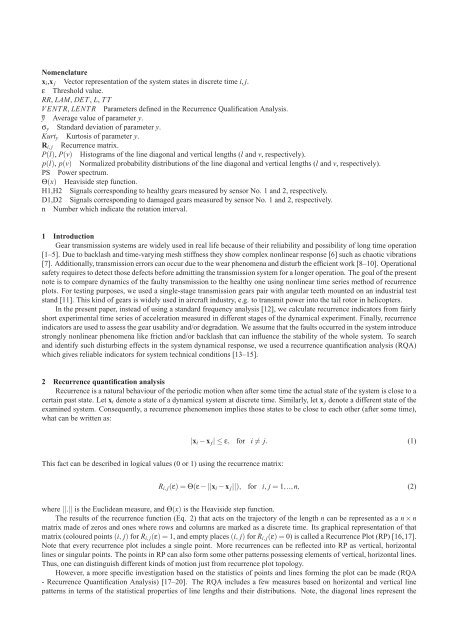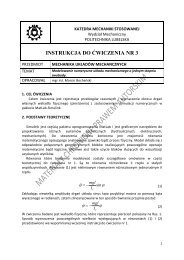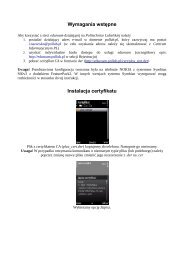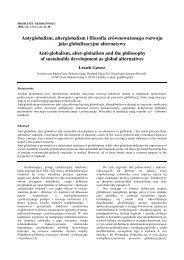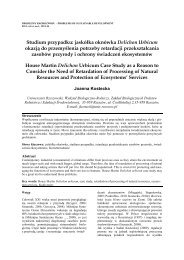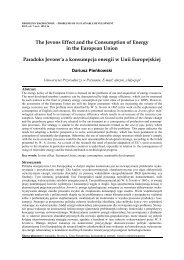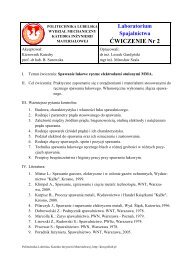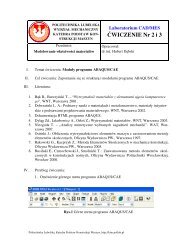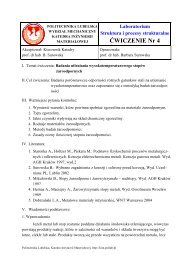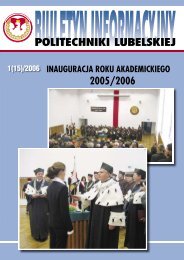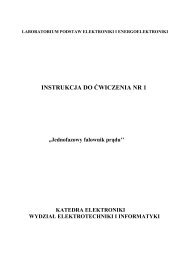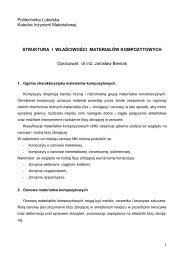pdf-preprint - Grzegorz Litak
pdf-preprint - Grzegorz Litak
pdf-preprint - Grzegorz Litak
You also want an ePaper? Increase the reach of your titles
YUMPU automatically turns print PDFs into web optimized ePapers that Google loves.
Nomenclaturex i ,x j Vector representation of the system states in discrete time i, j.ε Threshold value.RR, LAM, DET , L, T TV ENT R, LENT R Parameters defined in the Recurrence Qualification Analysis.y Average value of parameter y.σ y Standard deviation of parameter y.Kurt y Kurtosis of parameter y.R i, j Recurrence matrix.P(l), P(v) Histograms of the line diagonal and vertical lengths (l and v, respectively).p(l), p(v) Normalized probability distributions of the line diagonal and vertical lengths (l and v, respectively).PS Power spectrum.Θ(x) Heaviside step function.H1,H2 Signals corresponding to healthy gears measured by sensor No. 1 and 2, respectively.D1,D2 Signals corresponding to damaged gears measured by sensor No. 1 and 2, respectively.n Number which indicate the rotation interval.1 IntroductionGear transmission systems are widely used in real life because of their reliability and possibility of long time operation[1–5]. Due to backlash and time-varying mesh stiffness they show complex nonlinear response [6] such as chaotic vibrations[7]. Additionally, transmission errors can occur due to the wear phenomena and disturb the efficient work [8–10]. Operationalsafety requires to detect those defects before admitting the transmission system for a longer operation. The goal of the presentnote is to compare dynamics of the faulty transmission to the healthy one using nonlinear time series method of recurrenceplots. For testing purposes, we used a single-stage transmission gears pair with angular teeth mounted on an industrial teststand [11]. This kind of gears is widely used in aircraft industry, e.g. to transmit power into the tail rotor in helicopters.In the present paper, instead of using a standard frequency analysis [12], we calculate recurrence indicators from fairlyshort experimental time series of acceleration measured in different stages of the dynamical experiment. Finally, recurrenceindicators are used to assess the gear usability and/or degradation. We assume that the faults occurred in the system introducestrongly nonlinear phenomena like friction and/or backlash that can influence the stability of the whole system. To searchand identify such disturbing effects in the system dynamical response, we used a recurrence quantification analysis (RQA)which gives reliable indicators for system technical conditions [13–15].2 Recurrence quantification analysisRecurrence is a natural behaviour of the periodic motion when after some time the actual state of the system is close to acertain past state. Let x i denote a state of a dynamical system at discrete time. Similarly, let x j denote a different state of theexamined system. Consequently, a recurrence phenomenon implies those states to be close to each other (after some time),what can be written as:|x i − x j | ≤ ε, for i ≠ j. (1)This fact can be described in logical values (0 or 1) using the recurrence matrix:R i, j (ε) = Θ(ε − ||x i − x j ||), for i, j = 1,..,n, (2)where ||.|| is the Euclidean measure, and Θ(x) is the Heaviside step function.The results of the recurrence function (Eq. 2) that acts on the trajectory of the length n can be represented as a n × nmatrix made of zeros and ones where rows and columns are marked as a discrete time. Its graphical representation of thatmatrix (coloured points (i, j) for R i, j (ε) = 1, and empty places (i, j) for R i, j (ε) = 0) is called a Recurrence Plot (RP) [16,17].Note that every recurrence plot includes a single point. More recurrences can be reflected into RP as vertical, horizontallines or singular points. The points in RP can also form some other patterns possessing elements of vertical, horizontal lines.Thus, one can distinguish different kinds of motion just from recurrence plot topology.However, a more specific investigation based on the statistics of points and lines forming the plot can be made (RQA- Recurrence Quantification Analysis) [17–20]. The RQA includes a few measures based on horizontal and vertical linepatterns in terms of the statistical properties of line lengths and their distributions. Note, the diagonal lines represent the


